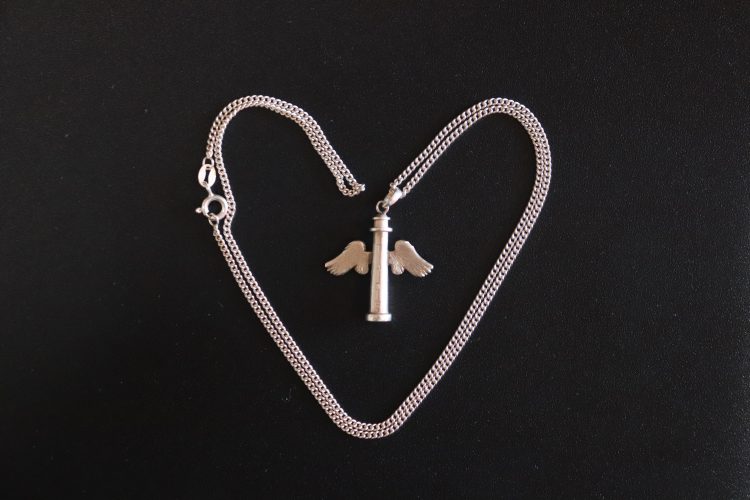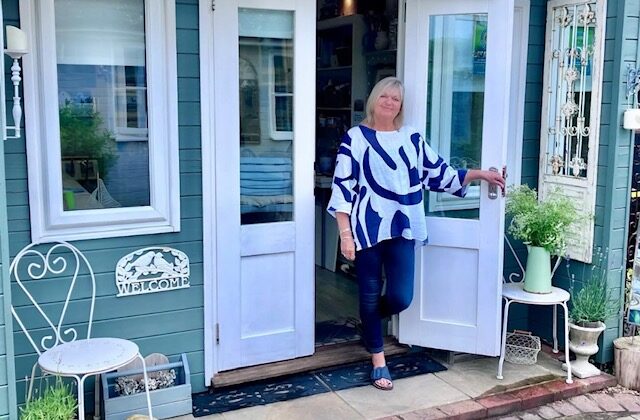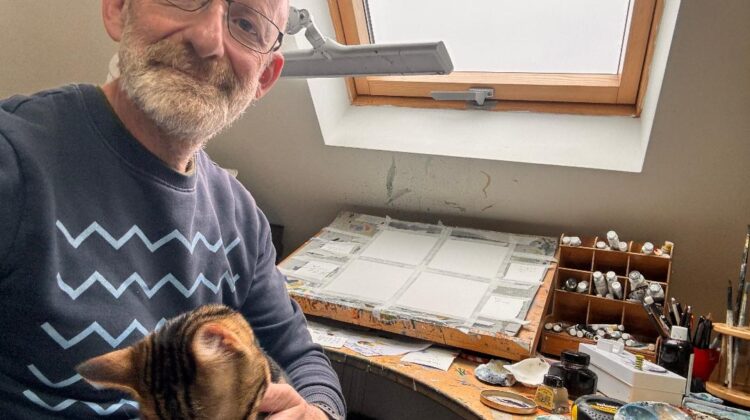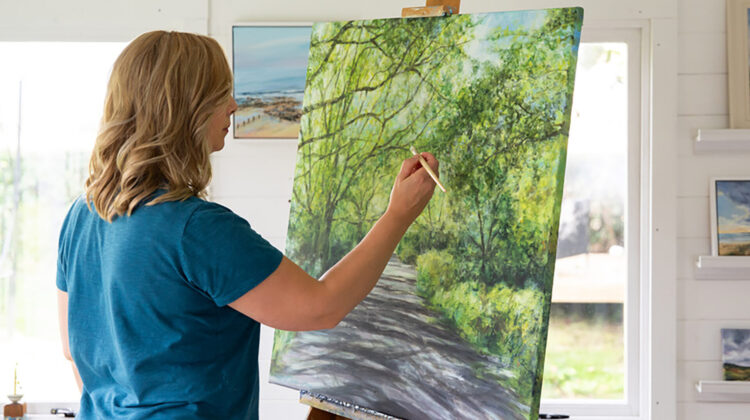Chichester Open Studios Artists
Creating in a Time of Isolation – Luke McEwen 2020

Posted by Nicola Hancock on 3rd April, 2020

One of last year’s artists sent this message on her feedback form:
I love doing the Art Trail; it offers an opportunity to see old customers, meet new ones, make useful contacts…and in a solitary profession, to share my work and time with people.
There are undoubtedly further reaching consequences than the loss of our Trail, but it is indeed an important opportunity for artists to open the doors to our creative domains and share our year long solitary efforts with an enthusiastic public.
Here is a another view of creativity and lockdown, beautifully expressed by Luke McEwen of Online Venue 71
-
... I’m writing this in the second week of the UK’s lockdown, on 31st March 2020. Originally this was going to be a simple blog about why I wanted to be an artist on Chichester’s Open Studios Art Trail, but COVID-19 has other plans. Do you recognise that story?
Nicola Hancock
You have your own story to tell us...
Luke McEwen
For me there is an incredible irony in this social isolation we are all facing. Let me explain. I’m a little unusual as an artist in that I don’t stick to one particular medium. I’m just as happy picking up my paint brush as I am throwing down a ball of clay on the wheel head, and then I might want to write a poem about it. But my one true love is writing stories. I wanted to lure you to my studio on the pretence of showing you my paintings and then shake my latest novel at you. It wasn’t such a Machiavellian plan – there were paintings to see as well. Essentially the Art Trail was to be my book launch.
-

Nicola Hancock
So, where’s the irony?
Luke McEwen
My novel, The Angel of Eddystone, is about my protagonist seeking a three-month retreat away from the rigours of modern living. They – I use ‘they’ to avoid spoilers – end up on a remote lighthouse fourteen miles off the coast of Devon which is notoriously difficult to get to. My protagonist has self-isolated!
If you’re like me, this lockdown has already caused massive turmoil. All my plans for the year have been cancelled or postponed. There are fears about financial uncertainty and worries about my physical well-being if I become infected. And above all, without the usual contact with friends, family and colleagues, I’m concerned about my mental well-being. How would I cope if I did a three-month stint in a lighthouse?
Eddystone is especially relevant, not because it’s a lighthouse but because you can’t easily escape its confines. Not without a lot of preparation and effort anyway. And that’s where we are now. It’s not that we mind being at home, it’s that we don’t have a choice. The COVID-19 lockdown is a prison sentence. We have to be very energetic and find new kinds of freedoms to prevent the isolation from overtaking our mood. This is one of the central themes of my novel. How do you turn hollow loneliness into a welcomed solitude? There is an opportunity here to reframe your lockdown and call it a retreat. You have the opportunity to spend more time with your best friend – that’s you.
There is a silver lining in this lockdown. I won’t push that too much as there are many dire consequences. But there is definitely some good arising from the devastation. The environment is showing immediate signs that recovery from global warming could happen much faster than expected if we change the way we live. And people are doing that – reappraising the way they live and re-ordering priorities.
This is very much what my protagonists needed too.
Part of my motivation for writing The Angel of Eddystone was to rebel against the modern trend to have strong protagonists with great wit, charm, sexual confidence, bravery, political correctness, intelligence, sophistication and, well… dullness? For although it’s great to see people championing the game of life, is it really like that for most of us?
From my own experience and that of the majority of people I know, life has a way of showing you how incredibly vulnerable and unprepared you are to deal with the circumstances you find yourself in. How many times do we conclude that we must have been very bad people in our previous lives to have earned such bad karma?
So when you meet my protagonists, you’ll find them broken, jaded and looking for an escape. Eddystone lighthouse is the location for their reprieve. It’s on a tiny reef nine miles from Rame Head, near Plymouth. But it’s not just the distance that makes the location remote. The interplay of tide and weather often make arrival by anything other than a helicopter impossible. There’s little opportunity to walk around. Your only opportunity for exercise would be a very perilous scramble on some rocks that pop their head out at low tide or climbing ten stories’ worth of staircases in the lighthouse.
I’m also celebrating my protagonist’s longevity. They’re in their early forties. I’m in my fifties so I feel I can describe them with some authenticity. My son, who is seventeen, probably thinks I should gracefully give up on the whole relationship thing – after all, what would I know about libido? Surely it’s time to don some slippers and ruminate over the details of my will? But I’m drawing on the zest for life my grandmother displayed. She loved life and partied hard, with finesse of course. Her lesson was clear – don’t waste a single day. My grandmother’s attitude brought me to Gabby, my heroine, who decides that despite yet another setback, she will not give up on her dreams.
-
Nicola Hancock
How does the opportunity for a retreat arise?
Luke McEwen
It is provided by a NASA research project that aims to assist interplanetary space travel. In my novel, I have projected my own thoughts about NASA’s needs, such as believing that we don’t need sophisticated scientists with an IQ of 175. We need well-balanced social beings who are self-contained and resilient enough to cope with the stresses of loneliness. When I think of old space films, I think of the crew slowly going mad because they are unable to cope with the remoteness and isolation. The films have a menacing atmosphere, with distrust growing among the crew, which of course makes a great story line. Typically, we watch the crew kill each other off one by one, although we’re not sure who the murderer is.
In my novel, NASA need a guinea pig to simulate the isolation experienced in a year’s long travel to Mars. Eddystone is the perfect location for their needs. There can be no illicit contact with their laboratory victim. And the subject will feel their physical remoteness as they look out from the lighthouse lantern to the faint lights on Devon’s south coast. Imagine looking out from your spaceship as the green and blue blob that is earth slowly fades to a pinprick.
How do you feel about spending three months on your own without any social media or phone contact? At least we still have that. If you had no opportunity to engage with the outside world and it was just you and your thoughts, would you manage? For many artists and writers, the isolation would be a dream come true – unfettered seclusion so that they could concentrate on their creations. Would that be enough for you, or would you be screaming to be let out of the prison after a few weeks?
My protagonist has the company of a couple of hundred birds, a blank journal for their poetry and thought doodles, and also their painting things. I’m not talking about cans of Dulux, but oils, acrylics and pastels, and a treasured half-inch filbert. That’s a type of paintbrush.
Trinity House
One of the central characters in my novel is Trinity House, the headquarters of the organisation responsible for England and Wales’s navigational aids, including Eddystone lighthouse, and the protection of seafarers. As part of my research I had a wonderful experience meeting some of their staff and spending time in their grand premises at Tower Hill, London. It was packed full of artefacts that the organisation has collected over its five-hundred-year history. Trinity House is a fascinating organisation, but rather than me tell you about them, I’ll let Mark do that.
Here’s an extract from The Angel of Eddystone:
I spent quite a few hours researching Trinity House’s operation and decided they were a curious bunch. More of a secret society than a big corporate. You’d expect the body that ran the nation’s lighthouses and navigational aids to be a fully-fledged government department, like the army or navy. But it was more akin to the Royal National Lifeboat Institute and was governed by some byelaws and a Royal Charter. The internal workings looked like how I imagine the Masons’ would be. Elder brethren are elected to form the Court, which in turn oversees a Corporate Board and the Lighthouse Board. You’d think something so important would be under parliamentary control. Looking at the list of members, however, the protection of our shipping is in safe hands. The Master of the Court is Her Royal Highness, the Princess Royal, KG, KT, GCVO. That’s Princess Anne to you and me. Of the rest of the court, about fifty of them, there were three other royals, seven admirals, eighteen captains, five commodores and seven right honourables.
The annual report showed that the organisation makes most of its money by charging commercial vessels for their use of the lighthouses, known as light dues. It only employs about three hundred people, a quarter of which are women. There are sixty-six lighthouses and eight light vessels to operate.
Reviews of The Angel of Eddystone
If you would like to sample my novel, please email me at Luke@lukemcewen.co.uk and I’ll send you a PDF of the first five chapters.
-

Nicola Hancock
That’s an interesting pendent. Is it your design?
Luke McEwen
Following my immersion in all lighthouse-related things and Trinity House, I thought about the possibility of having a keepsake made of my book that I could have with me at all times. This was the inspiration for having a pendent made of the symbol on the front cover – a lighthouse with wings. I could have tried to design it, but I’m no silversmith. But of course, having done the Chichester Art Trail, I had a selection of people to ask, and I’d heard of Tia already. Tia of Selkie Jewellery is not on the Art Trail this year. But this is a picture of her excellent work. I hope you will agree that her interpretation of my front cover is beautiful and I will treasure it all my life.
-

Nicola Hancock
Have you been to Eddystone Lighthouse?
Luke McEwen
Last summer I went on a motorbike tour of northern Spain and returned via the Santander Plymouth ferry, which passed by Eddystone lighthouse. I had never been so close. It was wonderful – a truly unforgettable treat.
I had gleaned all my knowledge of what it would be like to land on the lighthouse and walk down its many staircases and visit its many rooms from the forty-minute video of the experience filmed by Mike Palmer in 1990. He wrote a very good book on the lighthouse called Eddystone – The Finger of Light. Here is a link to the video
I am hoping my book does very well and that will persuade Trinity House that I might be allowed to walk the staircases of Eddystone myself. But given the multi-million pound set-up and the many thousands of others who’d like to visit, I won’t be waiting by the phone.
-
Nicola Hancock
From what I have read of your novel so far, you seem very interested in how we find happiness.
Luke McEwen
In the novel, I indirectly explore the approaches we take to happiness. One of my protagonists searches for it completely outside of themselves, the other completely within. The fact that these two people are relating causes some interesting insights. Neither approach works in isolation, of course – there’s that word again! We are constantly searching for happiness by interpreting our outside experiences through our internal worlds, then living out our conclusions via our external behaviour back in that outside world.
This is also seen in the yin and yang of seeking happiness through a relationship. Do we seek harmony by reflecting on and changing our internal world, or do we find it by trying to change the person in front of us? In the end, each strategy will fail because happiness comes from learning to reconcile each approach.
-
Nicola Hancock
It’s unusual to have so much poetry in a novel!
Luke McEwen
Can we finish with a poem? As does the book.
Yes there is quite a bit of poetry, certainly more than my editor would have liked! There isn’t too much poetry in the story, but probably more than my editor would have liked!
The poem is a modern take on an old theme – creating a fantasy from the briefest of encounters. Mark writes this poem after he sees a very attractive woman while waiting for an interview for a job – the same job she is applying for.
First sight: At the interview
I grip my seat in the waiting room
fiddling with answers to unknown questions.
A door closes, someone is leaving with words
that rise and fall like an angel’s song.
Turning, I see you in a golden dress;
beauty captures sense and sensation.
Oh, what a feast I consume without tasting.
Eyes lift and meet, and as I read, I am read.In the first step you take towards me
I have written and lived our story:
our earnest chatter that leads to laughter,
mad moments of sharing and knowing all,
first kisses, second bases, free falling
love surrendered, joyful arms and legs
that pull and push, squeeze and release
and as you take your next step, I am spent.Did your eyes read this final chapter
sharing my hopeful, yearning reverie,
lament the last step which left me alone
with your spicy, sweet scent and memory?





